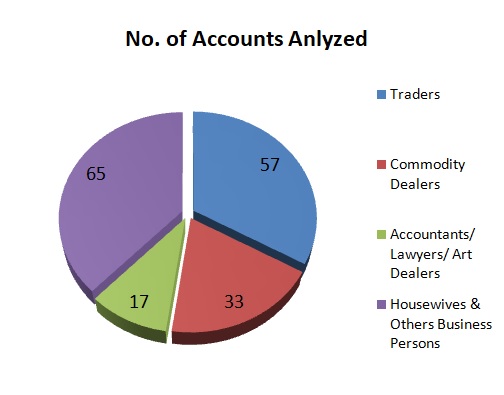Strategic Analysis
Aim & Objective
FMU’s strategic analysis provides insights for government and industry on money laundering and terrorism financing (ML/TF) risks, trends and methods.
The aim of the strategic analyses is to assist stakeholders by providing information that might be helpful in identifying and mitigating the risk of their business being used by criminals. This information can
- be relevant to their AML/CFT programs, policies and procedures
- help to inform their management and mitigation of ML/TF risk
- enhance the quality of reporting to FMU.
Purpose
To provide information on trends, patterns, vulnerabilities and indicators associated with the accounts of traders, commodity dealers, accountants, lawyers, fine arts dealers and housewives.
Methodology of Analysis
The study is based on analysis of significant number of suspicious and currency transaction reports (STRs/CTRs) on traders, commodity dealers, accountants, lawyers, fine arts dealers, housewives and other business persons that Financial Monitoring Unit receives under AMLA -2010 from the reporting entities including banks, exchange companies, insurance companies and security brokerage houses, etc.
| Chart of Professions & Accounts Analyzed | ||
| Sr .No | Professions | No. of Accounts Analyzed |
| 1 | Traders | 57 |
| 2 | Commodity Dealers | 33 |
| 3 | Accountants/ Lawyers/ Art Dealers | 17 |
| 4 | Housewives & Others Business Persons | 65 |
| Total | 172 | |

Trends & Patterns Analyzed
During our analysis of these reports it was found that the individuals involved in these reports were maintaining multiple business and personal accounts with different Financial Institutions. Some of them were running personal accounts singly as well as jointly with their family members, and were conducting high value transactions through these accounts in shape of cash deposits / withdrawals, clearing instruments, inter accounts transfers, inward/outward remittances in the form of Foreign Exchange (FX) receipts and payments. They were also conducting structured cash transactions below the threshold level to avoid reporting under AMLA 2010.
During the analysis of accounts statements and currency transactions reports, it was observed that the involved suspects were showing high volumes and frequent movements of funds in their accounts i.e. high opening and low closing balances were observed. Further, instances were noticed where individuals involved in these reports were operating trust accounts in addition to multiple personal and business accounts. Moreover, high value payments receipt transactions related to precious fine art work were also reflected in the accounts of certain individuals on behalf of close relatives and family members.
Besides, these individuals were also involved in frequent buying and selling of foreign currencies from open markets through different exchange companies as well as structuring FX transactions through family members. Moreover, frequent deposit/withdrawal transactions in their FCY accounts at banks were also observed in parallel to activity in open exchange market.
Money Laundering Vulnerabilities
The accounts of the traders, lawyers, accountants, commodities dealers, trusts and housewives carries high risk of money laundering because of nature of business and profession. The following functions provided by lawyers, accountants and other professionals are most useful to potential money launderer:
- Creating and managing corporate vehicles or other complex legal arrangements, such as trusts. Such arrangements may serve to obscure the links between the proceeds of a crime and the perpetrator.
- Buying or selling property. Property transfers serve as either the cover for transfers of illegal funds (layering stage) or the final investment of proceeds after they pass through the initial laundering process (integration stage).
- Performing financial transactions. Sometimes these professionals may carry out various financial operations on behalf of the client (for example, issuing and cashing checks, making deposits, withdrawing funds from accounts, engaging in retail foreign exchange operations, buying and selling stock, and sending and receiving international funds transfers).
- Providing financial and tax advice. Criminals with large money to invest may pose individuals hoping to minimize tax liabilities or seeking to place assets out of reach in order to avoid future liabilities.
- Providing introduction to financial institution.
- Undertaking certain litigation.
- Setting up trusts / Non-Profit Organizations (NPOs) and managing charity funds.
- Transactions related to precious fine art work are vulnerable to money laundering because of value and price determination of work as well as the nature of the art.
- The multi-million dollar fine art industry can also serve as convenient money laundering vehicle. Anonymous agents at art auction houses bid millions of dollars for priceless works. Payment is later wired to the auction house by the agents’ principals from accounts in offshore havens. It is an ideal mechanism for the money launderer.
- Use of multiple business, personal and family member accounts poses money laundering risk and provides the mean for placement, layering and integration of
- Use of multiple accounts can also help the individuals involved in making tax evasion by diverting/layering business revenues in different business, personal and family member accounts and hiding of funds from the revenue authorities.
- Use of family members, close relatives and others can also serve the purpose of maintaining accounts for performing of benami transactions.
- Frequent buying and selling of FCY from open market also carries the risk of hoarding of currencies for creating exchange rates volatility in the markets and capital flights through use of Hawala /Hundi Service Providers (HOSPs).
Conclusion & Recommendations
Money laundering has its multiplier socio- economic effects; it cripples down the economy and ruins economic growth. Of the underlying form of illegal activity, tax evasion is, perhaps, the one with most obvious macroeconomic impact. Money Laundering diminishes government tax revenue and, therefore, indirectly harms honest tax payers. It also makes government tax collection more difficult. This loss of revenue generally means higher tax rates than would normally be the case.
Based on available information and analysis the financial intelligence was shared with authorities for probing of possible tax related frauds under the Anti Money Laundering Act-2010 of Pakistan.

